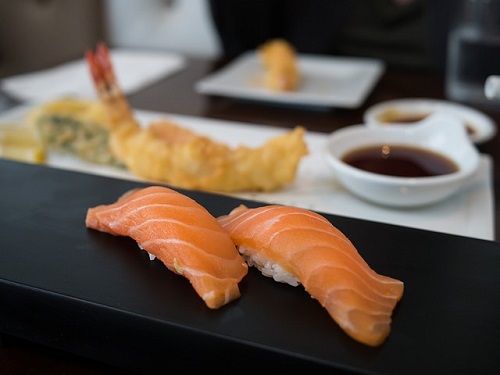
Japanese cuisine is becoming more and more popular around the world and especially in the United States. For many individuals who have not experienced Japanese dining-and especially their most famous dish, sushi-the terms on the menu can be particularly confusing. There are many different variations of sushi and other Japanese dishes that may be very similar but have some slight differences. Two such terms are nigiri and sashimi. These two terms are sure to appear under the sushi section of any Japanese menu so it is worth taking a little time to understand the difference between the two.
- Origin and meaning
A staple of the Japanese diet is sushi, which refers to the preparation and serving of cooked vinegared rice that may be combined with various other ingredients. Sushi itself came from Southeast Asia originally in which salted fish was stored in fermented rice for storage, and the literal meaning of sushi is ‘sour-tasting.’ However, modern sushi tastes far different than its predecessor as the preparation process has been refined over the centuries. As time passed, several specialty styles of sushi gained popularity. One of these, nigirizushi, commonly called nigiri in English, still enjoys popularity. Nigirizushi literally means ‘hand-pressed sushi’ and consists of a mound of sushi rice that is pressed between the palms of the chef’s hands to form an oval ball. Once the ball is formed, a topping, called the neta, is draped over it. This usually consists of raw or seared fish. Temarizushi is a type of nigirizushi that is made by pressing the rice and fish into a ball form by hand using plastic wrap.[i]
Sashimi is a little different from nigiri, primarily because it is not considered to be a type of sushi. Sashimi is a Japanese dish independently. The word sashimi means ‘pierced body’ and the origins of the dish date back to the early 14th century. It is thought that the word may derive from the practice of sticking fish tails in between the slices of fish to determine the type being eaten. Another theory is that it refers to the method in which ‘sashimi-grade’ fish are caught with an individual handline. Once landed, the brain is pierced with a sharp spike. This process is known as the ike jime process and it causes instantaneous death which minimizes the amount of lactic acid in the fish’s body. Once placed on ice, the fish will keep for about ten days with no degradation.[ii]
- Components
Nigiri is commonly comprised simply as sushi rice with either raw, smoked or seared fished placed across the ball of rice. The fish is typically called the neta. When the fish is partially grilled it is called aburi, though it is more commonly found to be completely raw. Fish typically used for nigiri are tuna, Japanese amberjack, yellowtail, snapper, mackeral, and salmon. Other seafood may also be used including squid, eel, pike conger, octopus, shrimp, clam, roe, sea urchin, abalone, prawns, scallops, and sometimes even oysters. One type of nigiri is called gunkanmaki and consists of the hand-formed ball of rice and topped with a loose ingredient that requires a strip of nori (black seaweed wrapper) be used to affix the topping to the rice. Types of gunkanmaki include toppings such as roe, natto, oysters, uni, corn mixed with mayonnaise, scallops and quail eggs. Nigiri is rarely served with any ingredients other than the sushi rice and the neta. However, it does usually come with some condiments. This would include soy sauce, wasabi, and gari, which is a sweet, pickled ginger. Some nigiri might be garnished with grated daikon (Asian white radish), thinly sliced vegetables or seaweed salad.[iii]
Sashimi seems much simpler; in that it is only comprised of thin slices of fish or seafood draped over a garnish such as daikon or thing strands of the shiso herb. It is commonly served with condiments such as wasabi paste, soy sauce and grated fresh ginger. The wasabi is typically mixed with the soy sauce, which is not usually done when eating sushi. Occasionally, sashimi may consist of vegetarian items such as yuba (bean curd skin), beef, horse meat or chicken, but it is predominantly composed of fish such as tuna, salmon, squid, octopus, shrimp, mackeral, yellowtail, scallop, sea urchin and whale.[iv]
- Preparation and eating etiquette
Preparing nigiri is rather informal compared to the preparation of sushi, and it can be eaten with either chopsticks or one’s hands.[v]
Despite its simplicity, the preparation of sashimi is quite a deal more complex than it is for nigiri. The grade of fish used is only the highest available, sashimi grade, and the manner in which the sashimi is prepared is very precise. It is considered to be the finest dish in Japanese cuisine by many Japanese chefs, and sometimes the preparation of sashimi can be considered an art form. The chefs will cut it into slices of different thickness to highlight the fish’s appearance. For fish such as tuna, salmon, and kingfish, the hiraq-zukuri (rectangular) cut is used in which it is sliced to be about the size of a domino and about 3/8 of an inch thick. Firmer fish, like bream, whiting and flounder, will receive a uzu-zukuri cut, which is extremely thing and diagonal. The dimensions are approximately 2 inches long and 1/16 of an inch wide. Sashimi that is cut into small thick cubes that are about ¾ of an inch on all sides are cut with the kaku-zukuri (square) cut. And finally, garfish and squid are usually cut into thin sheets that are less than 1/16 of an inch thick using the ito-zukuri cut (thread slice).[vi] Sashimi is a delicacy and should be enjoyed using chopsticks as the only utensil. It is never to be eaten with hands. [vii]











